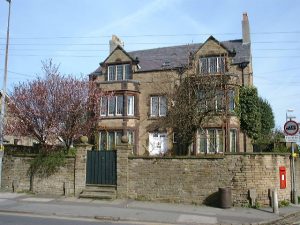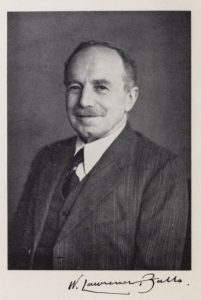
7 Bollington Road (north side), originally named Manor House. Originated as a farmhouse built in the early 17th century, with alterations to the façade in the early 20th century. It is built in sandstone and has a welsh slate roof. The house is in two and a half story’s, nearly symmetrical and has a three bay front. The outer bays contain two-story caned bay windows. Above these are half dormers with coped gables and ball finials. |
Census
1906: Richard Knowles was living at Orchard House according to Kelly’s Directory.
1911: The Knowles family in more detail were, Richard Ernest Knowles aged thirty nine years was a cotton merchant from Broughton in Lancashire. His wife Dorothy was thirty one years old and was from London. They had three daughters aged from one to six years and all were born in Bollington. Their servants were one cook and a domestic nurse. It is thought Richard Knowles referred to Orchard House as the ‘Manor House’ at this time although I have since learnt that a `Manor House` was situated just a couple of hundred meters down Moss Brow on the right, now divided into three cottages. By 1913 the Kelly`s Directory list Richard E Knowles as having moved to next door Barley Grange.
1918: Charles Henry Haigh was living at Orchard House and had been from at least 1914. However, listed on Bollington Photos Archives is a photograph of James and Bessie Barnshaw saying they lived there in 1918.
1923: William Lawrence Balls![]() (below) 1882-1960 lived at Orchard House for three years. He was a Doctor Of Science and was awarded a CBE 1934. He was given an Honorary Fellowship of the Textile Institute in 1943 and appointed Companion of the Order of St Michael and St George
(below) 1882-1960 lived at Orchard House for three years. He was a Doctor Of Science and was awarded a CBE 1934. He was given an Honorary Fellowship of the Textile Institute in 1943 and appointed Companion of the Order of St Michael and St George![]() (CMG) in 1944. He was also awarded an Honorary Doctorate in 1953.
(CMG) in 1944. He was also awarded an Honorary Doctorate in 1953.
Below is an extract from Royal Society Publishing, click on images to enlarge.
1939: Francis P. Slater lived at Orchard House, he was forty six years old and was a Research Director of Textiles. He lived with his wife Mary, two daughters Frances and Kathleen and one servant Ethel Foxall.
1955: or later Orchard house was occupied by Mr James Mitchell Renton, a textile agent and local Councillor, and his wife Rosemary Constance, who began the Bollington Art Group. Mrs Renton was better known as Binky. They had two sons David and John. They later moved to Higher Lane in Kerridge in 1970. Thank you to John Renton for more updated information.
The house was later bought by Graham and Ann Farrell who only lived in it for a short time and then sold it to the King family.
David and the now late Brenda King bought Orchard House in 1977 and for four years David had his dental surgery there in the two front rooms before moving to it’s current position on Bollington Road.
The plaque (below) is known as a `Dead Man’s Penny`. This one is embedded in a wall above a fireplace and hidden behind a large mirror. It is about a foot wide from memory.These were issued to the families of those who had died in WWI. The dead man’s name in this example Arthur Rigby, was displayed in the rectangle above the lion’s head. It is not known who Arthur Rigby was, he does not appear on any local war memorials. But there are at least two possibilities. Arthur Rigby, service number 308949 died 09/11/1918. He was a gunner with the Royal Garrison Artillery in Lancashire. Another Arthur Rigby with service number 291243 died 22/10/1917 aged 25 years. He was with the Suffolk regiment so probably not this Arthur. Having said that most soldiers enlisting from 1916 did not have a choice as to which regiment they signed up to, so maybe it was him. More research is needed to find his connection with Orchard House.

Listed structures
See Listed Buildings page for the full list and notes regarding Listed, Article 4, and SPD properties.
The links on the structures are to the Historic England web site. Any links to local history pages are to this web site.
 |
Orchard House, 7 Bollington Road |
Acknowledgements
Our thanks go to Linda Stewart who has researched census information to present an interesting history of the house’s residents. Also many thanks to the late Brenda King for allowing access to Orchard House.
Your Historic Documents
Please don't chuck out those historic documents and pictures! Find out why here.

